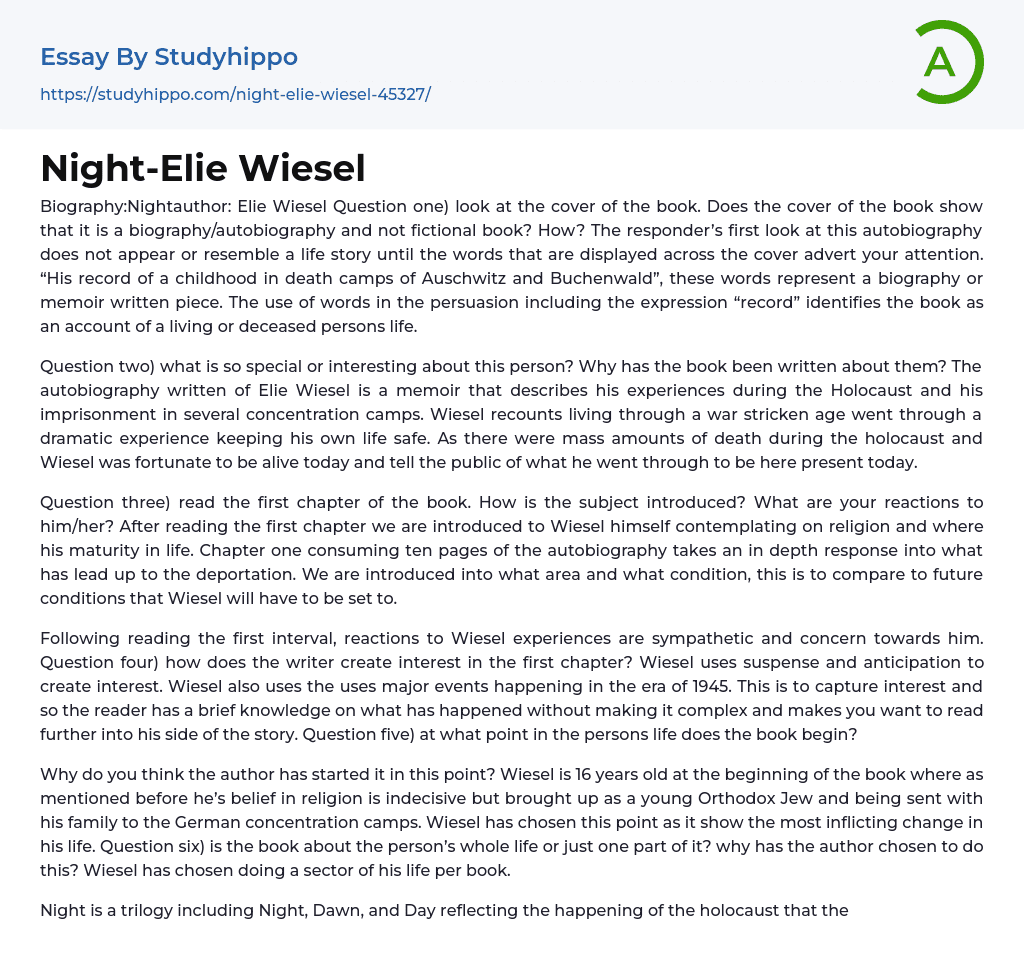- Question one) look at the cover of the book. Does the cover of the book show that it is a biography/autobiography and not fictional book? How? The responder’s first look at this autobiography does not appear or resemble a life story until the words that are displayed across the cover advert your attention. “His record of a childhood in death camps of Auschwitz and Buchenwald”, these words represent a biography or memoir written piece. The use of words in the persuasion including the expression “record” identifies the book as an account of a living or deceased persons life.
- Question two) what is so special or interesting about this person? Why has the book been written about them? The autobiography written of Elie Wiesel is a memoir that describes his experiences during the Holocaust and h
...is imprisonment in several concentration camps. Wiesel recounts living through a war stricken age went through a dramatic experience keeping his own life safe. As there were mass amounts of death during the holocaust and Wiesel was fortunate to be alive today and tell the public of what he went through to be here present today.
- Question three) read the first chapter of the book. How is the subject introduced? What are your reactions to him/her? After reading the first chapter we are introduced to Wiesel himself contemplating on religion and where his maturity in life. Chapter one consuming ten pages of the autobiography takes an in depth response into what has lead up to the deportation. We are introduced into what area and what condition, this is to compare to future conditions that Wiesel will have to be set
View entire sampleJoin StudyHippo to see entire essay - Question three) read the first chapter of the book. How is the subject introduced? What are your reactions to him/her? After reading the first chapter we are introduced to Wiesel himself contemplating on religion and where his maturity in life. Chapter one consuming ten pages of the autobiography takes an in depth response into what has lead up to the deportation. We are introduced into what area and what condition, this is to compare to future conditions that Wiesel will have to be set
to. Following reading the first interval, reactions to Wiesel experiences are sympathetic and concern towards him.
order. This is done so the reader understands thoroughly what has happened. Although there are few mentions to the future, these are all fully identified and have relevance to the chapter.
think this is exactly what was said at the time? How do you know why might an author use dialogue instead of simply describing what happened? An assortment of dialogue is used. What is said at the time may not be as written as in the book as after Wiesel’s traumatic experience it took 10 years to even speak of this tragic period of his life, therefore memories maybe altered. Apart from this, dialogue may have change to make the autobiography more alluring to promote the book.
- Anne Frank essays
- Adolf Hitler essays
- Concentration Camps essays
- Elie Wiesel essays
- Holocaust essays
- Nazi Party essays
- Weimar Republic essays
- Allegory essays
- Alliteration essays
- Comedy essays
- Comic book essays
- Drama essays
- Dystopia essays
- Fairy Tale essays
- Fantasy essays
- Fiction essays
- Ghost essays
- Gothic Fiction essays
- Gothic Literature essays
- Irony essays
- Legend essays
- Memoir essays
- Novel essays
- Poetry essays
- Satire essays
- Science Fiction essays
- Short Story essays
- The western essays
- Tragedy essays
- Witchcraft essays




